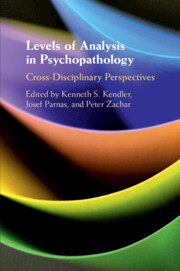Book contents
- Levels of Analysis in Psychopathology
- Advance Praise for Levels of Analysis in Psychopathology
- Levels of Analysis in Psychopathology
- Copyright page
- Contents
- Figures
- Tables
- Contributors
- Preface
- General Introduction
- Part I Neuroscience, Mechanisms, and RDoC
- Section 1
- Section 2
- 4 Introduction
- 5 Wrangling the Matrix: Lessons from the RDoC Working Memory Domain
- 6 Brain and Mind in Psychiatry? Presuppositions of Cognitive Ontology
- Section 3
- Part II Phenomenology, Biological Psychology, and the Mind–Body Problem
- Part III Taxonomy, Integration, and Multiple Levels of Explanation
- Index
- References
5 - Wrangling the Matrix: Lessons from the RDoC Working Memory Domain
from Section 2
Published online by Cambridge University Press: 02 April 2020
- Levels of Analysis in Psychopathology
- Advance Praise for Levels of Analysis in Psychopathology
- Levels of Analysis in Psychopathology
- Copyright page
- Contents
- Figures
- Tables
- Contributors
- Preface
- General Introduction
- Part I Neuroscience, Mechanisms, and RDoC
- Section 1
- Section 2
- 4 Introduction
- 5 Wrangling the Matrix: Lessons from the RDoC Working Memory Domain
- 6 Brain and Mind in Psychiatry? Presuppositions of Cognitive Ontology
- Section 3
- Part II Phenomenology, Biological Psychology, and the Mind–Body Problem
- Part III Taxonomy, Integration, and Multiple Levels of Explanation
- Index
- References
Summary
This chapter describes the National Institute of Mental Health (NIMH) Research Domain Criteria (RDoC) initiative, illustrating how elements from different “levels” or “units” of analysis are represented as domains, constructs, and subconstructs to form the RDoC “matrix.” The example of “working memory” is used to show that the matrix possesses conceptual elements drawn from diverse theories and experiments about working memory, but lacks a controlled vocabulary and specification of putative relations among the elements, that would serve as an organizing framework. An ontology (in the informatics sense) can be developed using existing tools to represent and analyze relations between most adjacent levels, with a notable exception: the link between cellular/network systems and observable behavior, which directly confronts the mind-body problem. Finally, the chapter considers how the field may best wrangle with the RDoC matrix using bottom-up and top-down strategies, while leveraging advantages and avoiding pitfalls of computational models and artificial intelligence.
Keywords
- Type
- Chapter
- Information
- Levels of Analysis in PsychopathologyCross-Disciplinary Perspectives, pp. 59 - 77Publisher: Cambridge University PressPrint publication year: 2020
References
- 3
- Cited by



